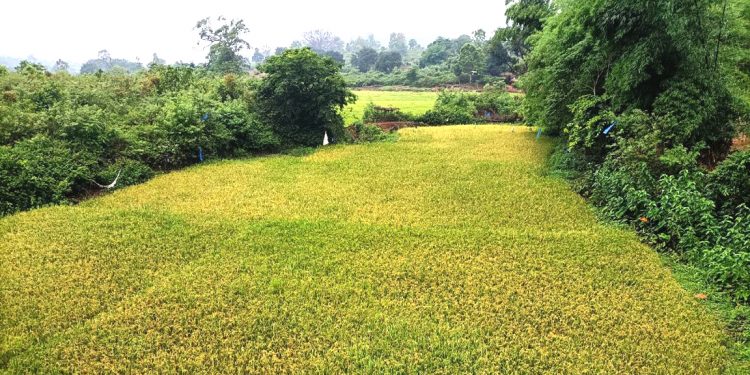Keonjhar: Paddy is cultivated on the Baitrani river bed in Keonjhar district.
It may sound strange for how the same river, that has been creating floods and causing massive destruction in Keonjhar and Bhadrak districts, is a boon for the members of the Juanga tribe, a Particularly Vulnerable Tribal Group (PVTG) living in Gonasika area under Bansapal block.
If you travel along Jantari road from Gonasika, you will come across a bridge on the Baitarani river from where you can feast your eyes looking at lush and verdant paddy fields on both the sides of the river with paddy plants undulating in breeze.
In fact, Gonasika is the place from where the Baitarani river originates. As per the legends, the place gets its name as ‘Gonasika’ for the fact that the river would flow from one of the two nostrils of a cow head. Gonasika is the portmanteau of ‘Go’ and ‘Nasika’. While ‘Go’ means cow, ‘Nasika’ means nose.
Even today, the river, which is as thin as a thread, is flowing from the nostril of a cow head, but the cow head is a cemented one. From Gonasika, the river meanders down the Gonasika hill, burbling all the way.
The river disappears at a place and runs underground for about half a kilometre and is not visible from outside. For the Juangas, the river is as pure as the river Ganga.
“We worship the river as ‘Ganga Maa’ and this is why the place where the river disappears is called ‘Gupta Ganga’. We mainly survive on cultivation. Paddy and vegetable cultivation is being carried out on the Baitarani river bed since time immemorial,” observed Laxman Juanga, a resident of Gonasika area.
Since the flow of the river is slow, the Juangas grow paddy and vegetables on its river bed about one kilometre away from its origin. In Keonjhar district, it flows through Joda, Champua, Saharpada, Patana, Ghasipura, Anandapur and Hatadihi blocks.
In rainy reason, the river swells, brings in floods and wreaks havoc in Ghasipura, Anandapur and Hatadihi blocks. While the river is bane for some, it is a boon for others.
PNN







































